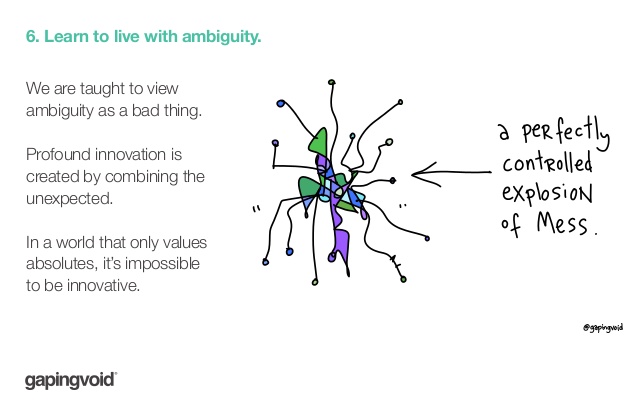am·bi·gu·i·ty
noun
• uncertainty or inexactness of meaning in language.
synonyms: vagueness, obscurity, abstruseness, doubtfulness, uncertainty;
• a lack of decisiveness or commitment resulting from a failure to make a choice between alternatives.
Ambiguity has potential to be a catalyst to new learning. It can be the spark to kindle lateral thinking and creative solutions to huge problems we face.
Ambiguity can be dangerous. It can lead us to be easily deceived in a world of fake news coupled with our tendency to be biased to more recent events and understanding.
Without ambiguity, we can only learn in additive ways, connecting our knowledge to what we already know. With ambiguity, we can learn exponentially and connect dots that could not have been connected before.
Without ambiguity, we can get stuck in a paradigm that limits our ability to problem solve. With ambiguity, we can literally begin to ‘think outside the box’ and to question the very boxes which we thought existed and contained us and our thinking.
“Learn to live with ambiguity.
We are taught to view ambiguity as a bad thing.
Profound innovation is created by combining the unexpected.
In a world that only values absolutes, it’s impossible to be innovative.”
But with ambiguity we can find confusion, frustration, and indecision. We can develop fear, anger, and a willingness to settle for a less desirable solution.
I find that we are now living in a world where Truth is subjective and ambiguous.
In the purist sense The Law seeks Truth. But in seeking Truth, policy and process supersedes common sense and fairness.
In the purist sense Religion seeks Truth. But in seeking Truth, kindness to neighbours and strangers seems secondary to devout faith.
In the purist sense Science seeks Truth. But in seeking Truth, the very choice of our experiments seem to subjectively alter what we find.
In a world where Truth is so ambiguous, biases can be so extreme, and simultaneously compassion and narcissism can ripple through our social media streams, a river of confusion can run through our minds.
There are potentials and dangers in ambiguity.
Ambiguity should not be a static state, but one that invites thought and action. It is positive when it is a transitory state, moving us to questions and solutions that enlighten us, and it is negative when it is a static state that absolves our curiosity and leaves us settling for rationalized solutions or compromised truths.
We don’t teach children to handle ambiguity well.
We see incredible value in ‘learning from our failures‘ but we do everything we can to stop children from failing, and thus learning through failure. We ask questions that they should know the answer to, or that they can find from unambiguous sources and resources. We use tests that ask ‘closed’ questions and rubrics that invite following the rules and guidelines.
If we don’t actively pursue opportunities for students to experience ambiguity, are we preparing them for the ambiguous world they are inheriting from us?
If we ourselves are not comfortable tackling ambiguity, are we modelling what we want to see in our students?
Ambiguity can be a necessary part of authentic and transformative learning experiences, but if it doesn’t lead to learning, it can lead to apathy, frustration, and complacency. ‘Learn to live with ambiguity’, but do not live in it.

Also published on Medium.

